Drywall sanders are essential tools for achieving smooth surfaces in construction and DIY projects․ They come in manual and electric versions, designed to efficiently sand drywall surfaces for a polished finish․
1․1 What is a Drywall Sander?

A drywall sander is a specialized tool designed to smooth and even out drywall surfaces, removing imperfections like joint compound bumps, nail holes, or tape lines․ It ensures surfaces are ready for painting or finishing․ Available in manual and electric versions, these sanders are portable and designed for precise control․ Manual sanders, such as hand-held blocks, are ideal for small areas, while electric models, like orbital sanders, handle larger tasks efficiently․ Both types are essential for achieving a professional-quality finish in construction and DIY projects․ They often feature adjustable speeds and interchangeable sandpaper grits, making them versatile for various sanding needs․
1․2 Importance of Drywall Sanders in Construction
Drywall sanders play a crucial role in construction, ensuring seamless and professional finishes in walls and ceilings․ Proper sanding eliminates imperfections, creating smooth surfaces for painting or finishing․ This process enhances the durability and appearance of drywall installations․ Additionally, sanders contribute to time efficiency, reducing labor costs by minimizing the need for extensive manual sanding․ They also help maintain indoor air quality by controlling dust during sanding․ With the right tools, contractors can achieve high-quality results, making drywall sanders indispensable for both small-scale and large construction projects․
Understanding Drywall Sanders
Understanding drywall sanders involves knowing their types, functionality, and purpose․ They are designed to smooth surfaces and remove imperfections, helping you choose the right tool for your project․
2․1 Types of Drywall Sanders
Drywall sanders come in various types, each suited for specific tasks․ Manual sanders, like sanding blocks, offer precision for small areas and detailed work․ Electric sanders, such as orbital and pole sanders, provide efficiency for larger surfaces․ Orbital sanders are ideal for smooth finishes, while pole sanders are perfect for ceilings and tall walls․ Wet sanders minimize dust but are slower, and vacuum sanders reduce mess with dust collection․ Choosing the right type depends on project size, surface complexity, and personal preference for manual or powered tools․
2․2 Manual vs․ Electric Drywall Sanders
Manual drywall sanders, such as sanding blocks, offer precision and control for small, detailed areas, ideal for fine-tuning and corners․ They require physical effort but are cost-effective and suitable for DIY projects․ Electric sanders, like orbital or pole sanders, are faster and cover larger areas, reducing time and effort․ Orbital sanders are best for smooth finishes, while pole sanders excel at ceilings and tall walls․ Electric sanders are more efficient for professionals or extensive projects, though they may lack the finesse of manual tools․ Choosing between them depends on project size, desired finish, and personal preference for speed versus precision․
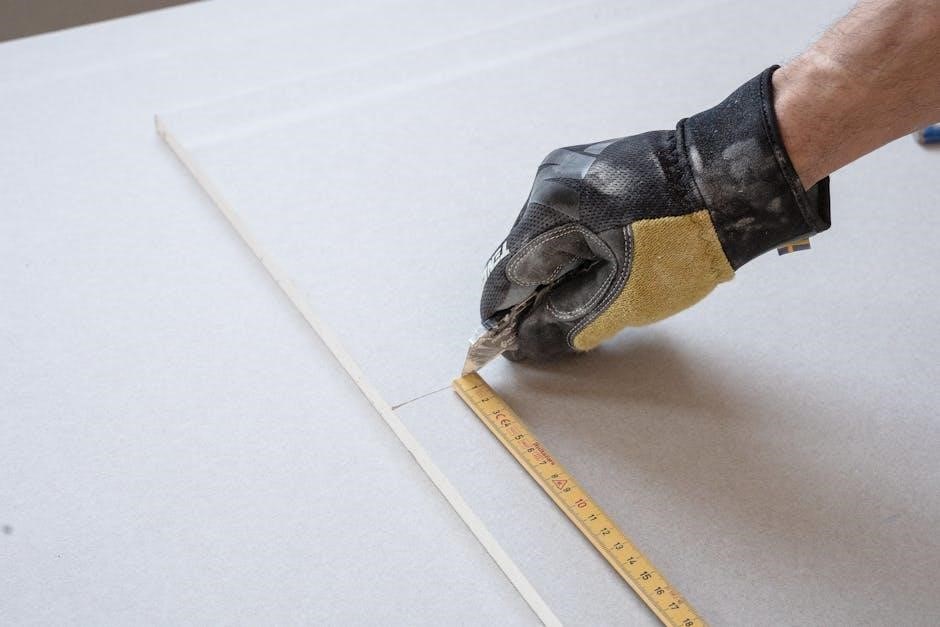
Selecting the Right Tools and Materials
Essential tools include manual or electric sanders, sanding blocks, and various grit sandpapers․ Accessories like vacuum attachments and dust-containment systems enhance efficiency and reduce cleanup efforts․
3․1 Essential Tools for Drywall Sanding
Manual drywall sanders, such as sanding blocks, are crucial for precision and control, especially in tight spaces․ Electric sanders, including orbital and pole models, offer efficiency for large areas․ Sanding sponges are ideal for corners and curved surfaces, while utility knives and joint compound tools help prepare surfaces․ A vacuum with a dust-collection attachment is vital for minimizing cleanup․ Sandpaper in various grits ensures proper progression from rough to smooth finishes․ These tools collectively streamline the sanding process, ensuring a professional-level result with minimal effort and dust․
3․2 Choosing the Right Sandpaper Grit
Selecting the appropriate sandpaper grit is crucial for effective drywall sanding․ Coarser grits (80-100) are ideal for removing joint compound and smoothing rough areas, while finer grits (150-220) are better for final touches to achieve a polished surface․ Using the correct grit progression ensures minimal dust and a high-quality finish; For manual sanding, start with medium grit and progress to finer grits for optimal results․ Proper grit selection enhances efficiency and reduces the risk of over-sanding, ensuring a seamless finish․
3․3 Accessories for Efficient Sanding
Accessories like sanding sponges, dust collection systems, and extension poles enhance the efficiency of manual drywall sanding․ Sanding sponges are ideal for corners and curved areas, offering flexibility and precision․ Dust collection systems, often built into electric sanders, minimize cleanup and reduce airborne particles․ Extension poles allow for reaching high ceilings and large surfaces without ladders, improving safety and coverage․ These accessories streamline the sanding process, ensuring a smoother finish with less effort and mess․ Incorporating them into your workflow can significantly improve both the quality of the result and the ease of the task․
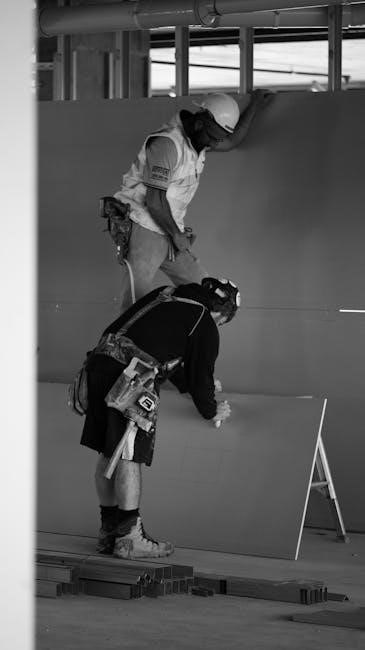
Safety Precautions and Protective Equipment
Always wear a dust mask or respirator, safety goggles, and a vacuum system to minimize dust exposure․ Work in well-ventilated areas to prevent dust dispersion and ensure safety․
4․1 Personal Protective Equipment (PPE)
When using a drywall sander, wearing proper Personal Protective Equipment (PPE) is crucial to ensure safety and minimize health risks․ A dust mask or respirator is essential to prevent inhaling fine drywall dust, which can cause respiratory issues․ Safety goggles or protective eyewear should be worn to shield eyes from debris․ Gloves protect hands from abrasions and provide better grip while handling the sander․ Additionally, using a vacuum system with the sander reduces airborne dust, enhancing safety․ Always ensure PPE fits properly and is used consistently during sanding operations to avoid accidents and long-term health concerns․
4․2 Ventilation and Dust Control
Proper ventilation and dust control are vital when using a drywall sander to minimize dust dispersion․ Open windows and doors to improve airflow, and use fans to direct dust particles away from the work area․ Covering floors, furniture, and other surfaces with drop cloths or plastic sheets prevents dust from spreading․ Utilizing a vacuum or HEPA-filter equipped sander significantly reduces airborne dust․ For additional containment, seal off adjacent rooms with plastic and tape․ Maintaining good ventilation and controlling dust not only enhances safety but also ensures a cleaner workspace and better final results, making the sanding process more efficient and professional․
4․3 Safe Handling of Power Tools
Safely handling power tools like electric drywall sanders is crucial to prevent accidents․ Always wear Personal Protective Equipment (PPE), including safety glasses, a dust mask, and gloves․ Ensure the tool is properly assembled and free from damage before use․ Maintain a firm grip and operate the sander with steady, controlled movements․ Avoid overreaching or applying excessive pressure, which can cause loss of control․ Keep loose clothing and long hair tied back to prevent entanglement․ Never leave the sander unattended while it’s running, and store it in a dry, secure location when not in use․ Regularly inspect the power cord and sanding pads for wear and tear to ensure safe operation․
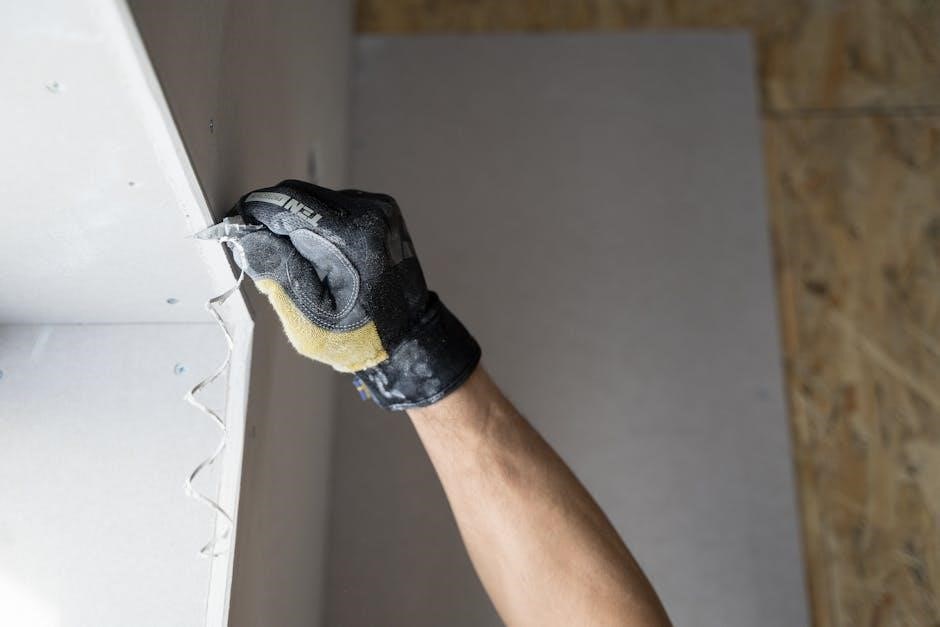
The Drywall Sanding Process
The drywall sanding process involves preparing the workspace, inspecting the surface, and using a sander to smooth out imperfections․ It ensures a seamless and professional finish․
5․1 Preparing the Workspace
Preparing the workspace is crucial for efficient drywall sanding․ Begin by clearing the area of furniture and cover floors with drop cloths or plastic sheets to protect them from dust․ Use masking tape to seal air vents and doorways, preventing dust spread․ Ensure good lighting to spot imperfections easily․ Lay out tools, including sanders, sandpaper, and safety gear․ A clean, organized workspace minimizes distractions and ensures a smooth sanding process․ Proper preparation also reduces cleanup time, making the entire project more manageable and professional․
5․2 Inspecting the Drywall Surface
Inspecting the drywall surface before sanding is essential to identify imperfections․ Use a bright light to reveal dings, pits, and uneven areas․ Circle these spots with a pencil for easy reference․ Check for joint compound cracks, nail pops, or screw depressions․ Ensure all seams are properly taped and mudded․ Look for areas where the drywall paper may be exposed or loose․ This step helps prioritize sanding efforts and ensures no flaws are missed․ A thorough inspection guarantees a smoother, more professional finish․ Addressing issues early prevents costly corrections later․
5․3 Using a Drywall Sander Effectively
Using a drywall sander effectively requires technique and patience․ Start by applying even pressure, using a push-pull motion for pole sanders or circular strokes for orbital sanders․ Begin with lower grit sandpaper (100-120) for rough areas and progress to finer grits (150-220) for smoothing․ Avoid applying too much pressure, which can damage the drywall․ Work in sections, ensuring consistent coverage․ For manual sanders, use light strokes and focus on edges and corners․ Regularly inspect the surface to address imperfections․ Sanding evenly ensures a smooth finish, reducing the need for additional coats of joint compound․
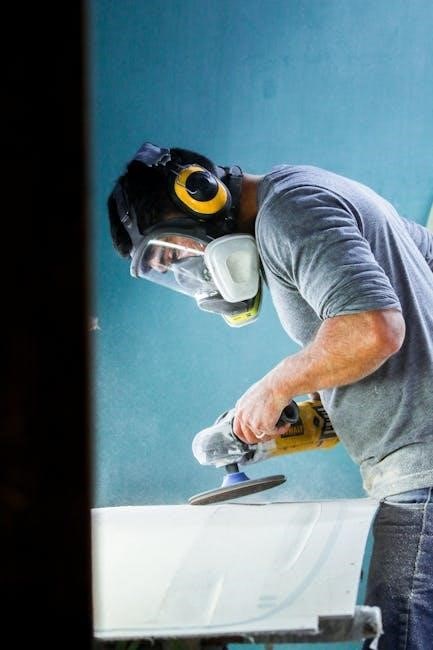
Sanding Techniques
Mastering sanding techniques is crucial for a professional finish․ Use push-pull motions for pole sanders and circular strokes for orbital tools․ Feather edges smoothly and employ sanding sponges for detailed areas, ensuring even coverage from rough to fine grits․
6․1 Basic Hand-Held Sanding Techniques
Hand-held sanding is ideal for small areas and precise adjustments․ Start with 100-120 grit sandpaper, using light, circular strokes to smooth imperfections․ Apply even pressure to avoid uneven surfaces․ For corners and edges, use a sanding sponge, which offers flexibility and control․ Work in small sections, inspecting as you go․ Avoid over-sanding, as this can create scratches or weaken the drywall․ Use a dust mask and ensure good ventilation to minimize dust exposure․ Transition to finer grits for a polished finish․ Sanding sponges are particularly effective for curves and corners, ensuring a seamless blend with surrounding areas․
6․2 Advanced Orbital Sander Techniques
For larger surfaces, orbital sanders offer efficiency and speed․ Start with coarse grit (80-100) to remove imperfections, then switch to finer grits (120-150) for a polished finish․ Use smooth, overlapping circular motions, applying light to moderate pressure․ Avoid applying too much force, as this can create swirl marks․ Keep the sander flat and steady, ensuring even contact with the surface․ Orbital sanders excel at covering extensive areas quickly but should be used cautiously near edges and corners to prevent damage․ Regularly vacuum dust and debris to maintain visibility and ensure a smooth finish․ This method is ideal for professionals seeking precision and efficiency in large-scale drywall projects․
6․3 Wet Sanding vs․ Dry Sanding
Wet sanding uses a damp sponge to minimize dust, ideal for detailed areas and small projects․ It reduces mess but requires more time and effort․ Dry sanding is faster and more aggressive, using sandpaper to remove imperfections quickly․ However, it generates significant dust, requiring proper ventilation and safety gear․ Wet sanding is perfect for precision, while dry sanding excels for large-scale projects․ Choose based on project size, desired finish, and personal preference to achieve optimal results efficiently․ Both methods complement each other, offering unique advantages depending on the task at hand․ Proper technique ensures a smooth, professional finish in either case․
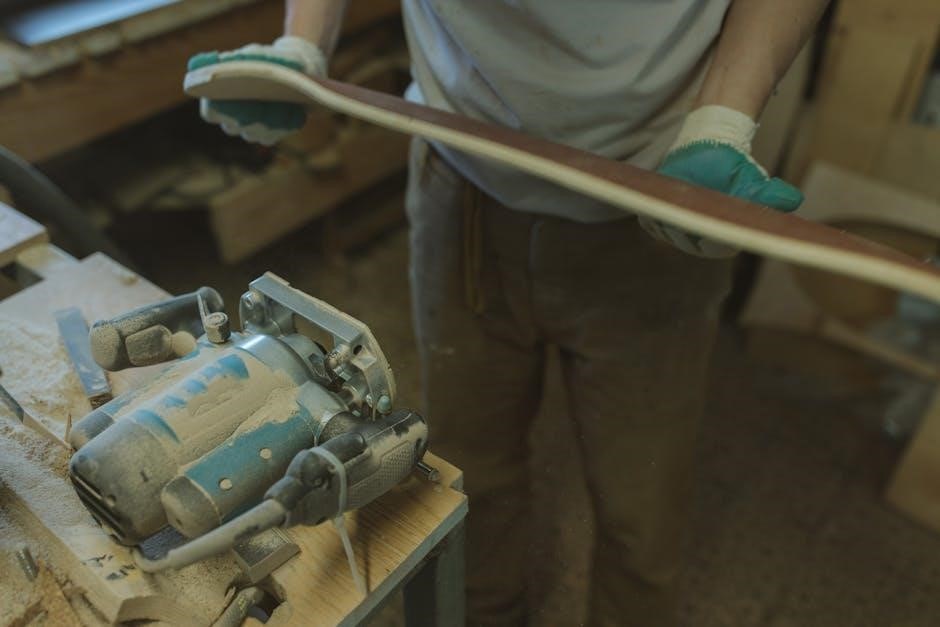
Tips for Achieving a Smooth Finish
Apply thinner joint compound layers to reduce sanding effort․ Use sanding sponges for corners and edges․ Avoid over-sanding to prevent surface damage․ Achieve a professional finish with patience and proper technique․
7․1 Applying Thinner Layers of Joint Compound
Applying thinner layers of joint compound minimizes sanding effort and reduces the risk of cracks and shrinkage․ This approach ensures faster drying times and a smoother finish․ It prevents excessive sanding, which can damage the drywall surface․ By using precise amounts, you maintain even coverage and avoid unnecessary repair work․ Professionals recommend thin coats for optimal results, allowing each layer to dry completely before applying the next․ This method is crucial for achieving a seamless, professional-quality finish in drywall projects․
7․2 Using Sanding Sponges for Corners
Sanding sponges are ideal for smoothing corners and detailed areas where larger tools struggle to reach․ Their flexibility allows precise control, ensuring even sanding in tight spaces․ For drywall, use a sponge with 120-150 grit sandpaper for finer details․ Light pressure prevents creating unwanted texture․ Sanding sponges are especially useful for curved edges and corners, providing a professional finish without over-sanding․ They complement manual sanders by addressing hard-to-reach areas, ensuring a seamless surface for painting or finishing․ This method enhances efficiency and reduces the risk of imperfections in intricate sections․
7․3 Avoiding Over-Sanding
Over-sanding can lead to uneven surfaces and potential damage to the drywall paper․ To avoid this, use light, consistent pressure and work in small, controlled motions․ Start with coarser grit sandpaper (100-120) for initial smoothing, then switch to finer grit (150-220) for finishing․ Avoid sanding in one spot for too long, as this can create depressions․ Regularly inspect the surface to ensure evenness․ Applying thinner layers of joint compound and allowing proper drying time minimizes the need for excessive sanding․ Proper technique and patience are key to achieving a smooth, professional finish without compromising the integrity of the drywall․

Troubleshooting Common Issues
Identify and address issues like dust buildup, uneven surfaces, and over-sanding․ Adjust techniques, use appropriate grit sandpaper, and ensure proper tool maintenance for optimal results․
8․1 Dealing with Dust and Debris
Dust and debris are inevitable during drywall sanding, but proper management is key․ Use drop cloths or plastic sheets to contain dust, and seal doorways with masking tape․ Employ sanders with vacuum attachments to minimize airborne particles․ For manual sanding, work in sections and use a damp sponge to reduce dust․ Regularly clean tools and surfaces to prevent debris buildup․ Wear protective gear, including a dust mask and goggles, to avoid inhalation and eye irritation․ After sanding, vacuum thoroughly and wipe surfaces with a damp cloth for a clean finish․ Proper ventilation and organization are essential for efficient dust control and a professional result․
8․2 Fixing Imperfections Without Sanding
Addressing drywall imperfections without sanding saves time and effort․ For small dents or scratches, apply joint compound directly and smooth with a trowel or knife․ Lightly press the compound into the area for a seamless blend․ Allow it to dry fully before painting․ For minor nail pops, tighten the nail and cover with compound․ Use a putty knife to feather the edges for a flush finish․ Avoid over-filling, as this can create new imperfections․ This method ensures quick repairs without the need for extensive sanding, maintaining a smooth surface and reducing dust generation․ Proper technique ensures professional-looking results with minimal effort․
8․3 Correcting Uneven Surfaces
Uneven drywall surfaces can be corrected by identifying high spots and addressing them systematically․ Use a light source to highlight imperfections, then apply pressure with a drywall sander to level the area․ Start with a lower grit sandpaper (e․g․, 100-120) for more aggressive removal, then switch to higher grit (150-220) for smoothing․ Feather the edges to blend seamlessly with the surrounding surface․ For deeper unevenness, apply additional joint compound, allow it to dry, and sand lightly․ Regularly inspect the surface with a light to ensure evenness․ This method ensures a professional finish without excessive sanding or material waste․
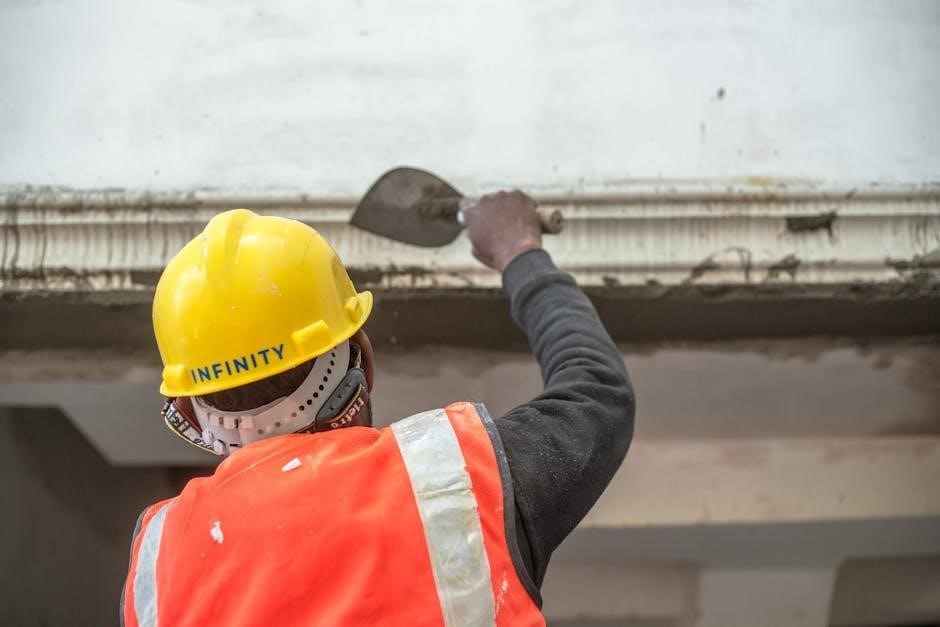
Maintenance and Care of Drywall Sanders
Regularly clean sanders to remove dust and debris․ Store in a dry place to prevent damage․ Replace sandpaper and worn parts promptly for optimal performance and longevity․
9․1 Cleaning and Storing the Sander
Cleaning and storing your drywall sander properly ensures its longevity and efficiency․ After use, remove dust and debris with a soft brush or vacuum․ Wipe the sander with a damp cloth, avoiding electrical components․ Store it in a dry, cool place, away from direct sunlight․ For manual sanders, ensure all moving parts are free from dust․ Proper storage prevents rust and maintains the tool’s effectiveness for future projects․ Regular maintenance helps extend the lifespan of your sander and ensures consistent performance․ Always follow manufacturer guidelines for specific cleaning instructions․
9․2 Replacing Sandpaper and Parts
Regularly replacing sandpaper and worn parts ensures optimal sander performance․ For manual sanders, simply peel off the old sandpaper and attach a new sheet, aligning it securely․ Electric sanders may require additional steps, such as loosening clips or screws to change sanding screens․ Always use the correct grit and size specified by the manufacturer․ Worn or damaged parts, like belts or brushes, should be replaced promptly to avoid reduced efficiency or damage to the motor․ Keep spare sandpaper and components on hand to minimize downtime․ Proper replacement maintains your sander’s effectiveness and extends its operational life, ensuring professional-grade results․
9․3 Regular Maintenance Checks
Performing routine maintenance ensures your drywall sander operates efficiently and prolongs its lifespan․ Begin by cleaning the tool, removing dust and debris from crevices and surfaces․ For electric sanders, inspect the power cord for damage and ensure all connections are secure․ Check the sanding pad or drum for wear; replace if necessary․ Lubricate moving parts if recommended by the manufacturer․ Store the sander in a dry, clean environment to prevent rust or damage․ Regularly check for loose screws or belts and tighten them as needed․ Scheduled maintenance not only prevents breakdowns but also ensures consistent performance, helping you achieve smooth, professional results every time․
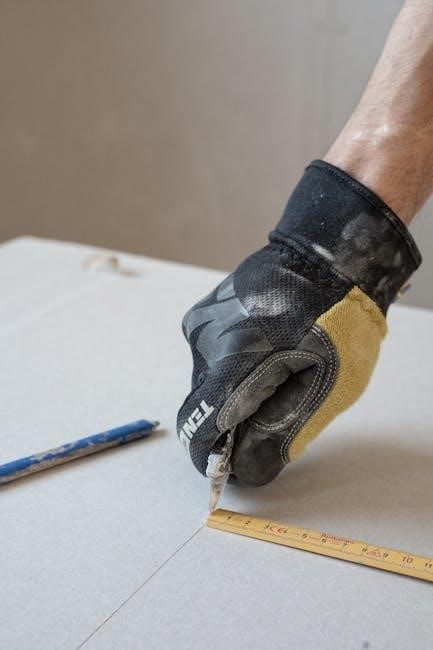
Mastery of the drywall sander is key to achieving professional, smooth finishes․ By using the right tools, techniques, and safety measures, you can ensure flawless results every time․
10․1 Summary of Key Points
Using a manual drywall sander ensures precision and control, especially for small or detailed areas․ Proper preparation, including applying thin joint compound layers, is crucial for minimizing sanding effort․ Selecting the right sandpaper grit and employing techniques like wet or dry sanding can significantly impact results․ Safety measures, such as wearing protective gear and maintaining good ventilation, are essential․ Regular tool maintenance and troubleshooting common issues, like uneven surfaces or dust management, enhance efficiency․ By mastering these strategies and tips, you can achieve a smooth, professional finish consistently․
10․2 Final Tips for Professional Results
For a flawless finish, always use the appropriate sandpaper grit and apply even pressure․ Start with coarse grit for imperfections and switch to finer grit for smoothing․ Utilize sanding sponges for corners and curved areas to ensure precision․ Avoid over-sanding, as it can damage the drywall surface․ Work in well-ventilated spaces and use protective gear to minimize dust exposure․ Regularly clean and maintain your tools for optimal performance․ By following these guidelines and practicing proper techniques, you can achieve professional-grade results with ease, ensuring smooth, even surfaces for painting or finishing․
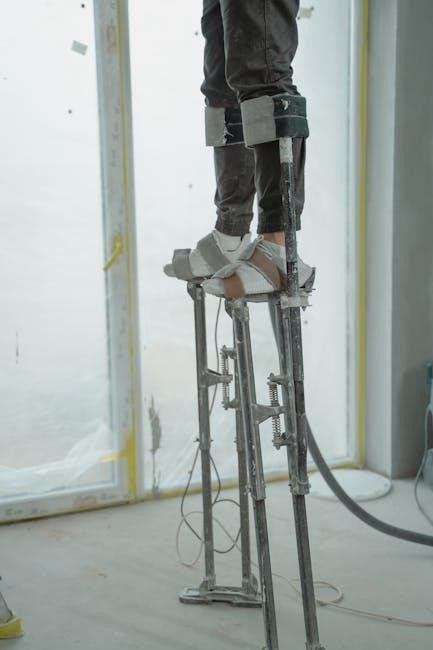
No Responses